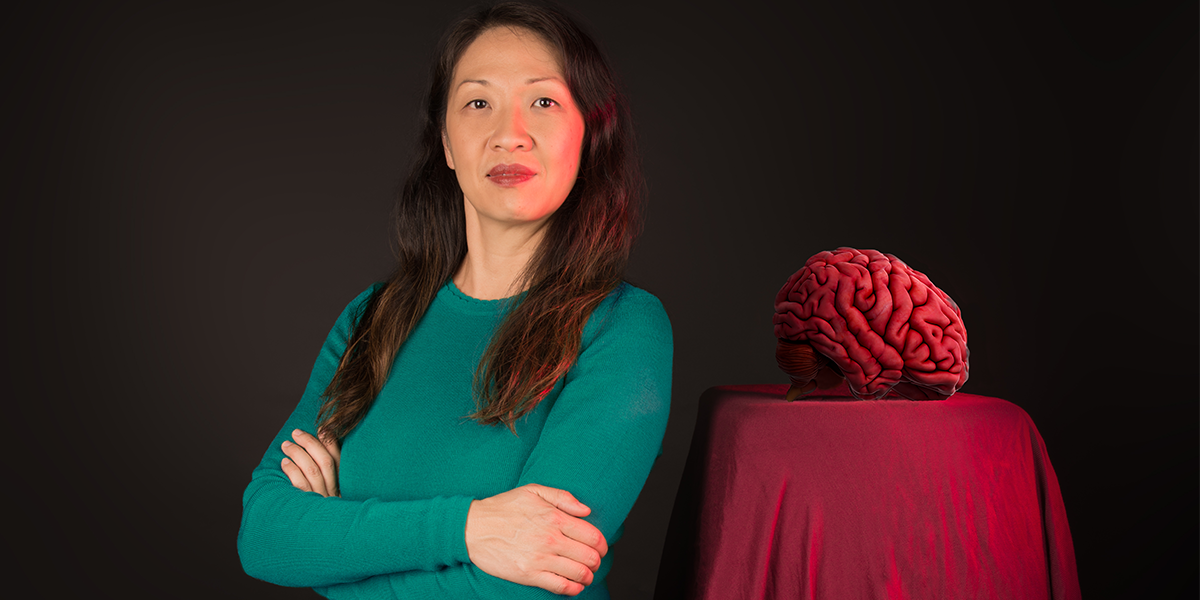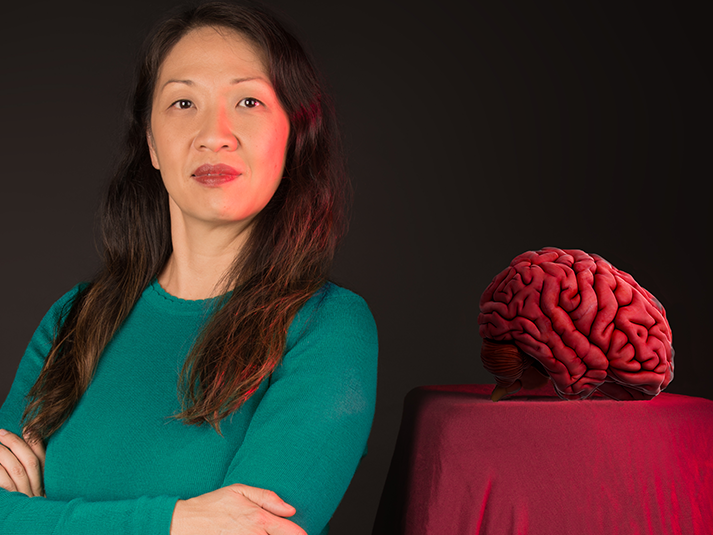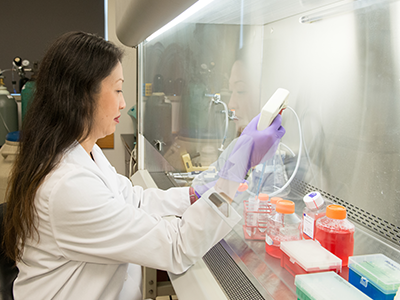
Cluster Analysis

Cluster Analysis
Originally Posted 9/01/2018 |
From the Fall/Winter 2018 Issue
If she only had a brain—for research purposes, that is. But in lieu of experimenting on the body’s most complex organ, stem cell biologist Jenny Hsieh builds her own smaller and much less complex version in a petri dish. It’s called a cerebral organoid, and Hsieh has brought her cutting-edge laboratory to UTSA as one of the university’s newest brain health cluster hires. Hsieh joins the university as the Semmes Foundation Chair in Cell Biology after working with UT Southwestern Medical Center in Dallas, and she will lead the UTSA Brain Health Consortium. Her work is supported by a $2.7 million gift from the Robert J. Kleberg Jr. and Helen C. Kleberg Foundation and a $1 million gift from the Semmes Foundation.
“It’s really exciting,” Hsieh says about her research into epilepsy and the possibilities that await at UTSA. “We are trying to model human brain disorders in a dish. We’re collecting blood samples from patients who have our disease of interest; then we can use the blood sample and reprogram their cells to become what’s called a pluripotent stem cell, which is a stem cell that can become a brain cell or any cell in the body.” Hsieh is establishing a core facility at UTSA to do that type of reprogramming, and once the stem cell lines are made, they can be distributed to other researchers.
“Over the next 10 years we will develop these personalized screening models for genetic brain disorders to try and find or predict medicines that work better or medicines that are less toxic and that can help guide the medical community,” Hsieh says. “It’s like a diagnostic test.”
The cluster hires focus on research subjects that are well-thought-out. They are synergistic with our community. San Antonio wants them to happen.
The growth of Hsieh’s lab over the next 10 years is a good example of how UTSA leadership wants to grow the entire university during that same time frame by expanding research opportunities for faculty and students and becoming a research enterprise among the best.
“We are building a density of talent at UTSA that’s two-pronged,” says President Taylor Eighmy. “First, we already have talented faculty and we need to help them to further develop professionally, especially as we think about our present and future areas of strength. Second, strategically hiring faculty who are leaders in their fields is one of the best ways we can rapidly differentiate ourselves as an institution and further build a nationally recognized research enterprise.”
“As a society, we are faced with many grand challenges such as how to live longer, healthier lives, prepare a workforce in the era of big data, and fuel economic development while stewarding our natural resources,” says Kimberly Andrews Espy, provost and vice president for academic affairs. “Addressing these challenges requires a collaborative effort where experts with different disciplinary backgrounds and approaches come together and develop new ideas and innovative solutions.”
“Cluster hiring is about accelerating these transdisciplinary efforts by hiring faculty who by design connect with colleagues in other areas and methods in order to do cutting-edge research and to engage our students with the latest information in the classroom,” Espy adds. “It’s a way to jumpstart collaborations in more intentional ways, while still supporting the creativity and disciplinary methodology of individual faculty to enhance the quality of our institution and the success of our students.”
Attracting the Best
Hsieh is just one example of the caliber of faculty being wooed by UTSA’s continued and aggressive focus to join the ranks of the country’s most elite research universities. Specific faculty in targeted clusters have been added throughout the university since 2016. These hires are in the university’s areas of research excellence: cybersecurity/cloud computing, analytics and data science, and brain health.

Brain Power
Hsieh has brought her cutting-edge laboratory to UTSA to work on diseases of the brain.
They join UTSA for a variety of reasons. Murtuza Jadliwala, hired in the spring as an assistant professor in computer science, says, “What attracted me most to UTSA was the enthusiasm and push I saw on campus toward achieving top research status. I really liked the university’s model of targeting critical growth areas, such as cybersecurity, toward achieving this goal. Moreover, the presence of prominent researchers at UTSA, such as Dr. Ravi Sandhu and Dr. Shouhuai Xu, who are already doing ground-breaking research in cybersecurity as well as state-of-the-art resources and research facilities (for example, the Institute for Cyber Security and the Center for Infrastructure Assurance and Security) further attracted me. UTSA has a great mix of excellent faculty, students, and research infrastructure to become a research powerhouse in this nationally critical area of cybersecurity, which made my decision to join UTSA as a cybersecurity faculty and researcher easy. Last, but not the least, my wife and I love the city of San Antonio and all that it has to offer, and we could not think of a better place to raise our 7-year old daughter.”
Yeonjoo Park, hired this fall as an assistant professor in the Department of Management Science and Statistics says she was attracted to UTSA’s diverse, multicultural environment. She has enjoyed how pleasant and kind the people are at UTSA.
Anthony Rios, an assistant professor in the Department of Information Systems and Cybersecurity, also hired this fall, says, “I decided to come to UTSA because it is one of the top universities under 50 years old that provides an environment for research excellence. Likewise, given the growth rate of the university, it offers me an exciting opportunity to have a substantial impact on its future.”
Striving Toward a Goal
The hires come as the university’s total research and development expenditures have reached $68.1 million during fiscal year 2017, an increase of 19.9% over the prior year. They also provide a foundation that aligns with Eighmy’s goals that will see UTSA entering a higher echelon. These goals include being recognized as an R1 Carnegie classification—designated as a nationally competitive research university.
The Carnegie Commission on Higher Education developed what has become the leading framework for classifying universities, based on research and policy analysis. The R1 classification is the highest level of research university and includes Brown, Cornell, Texas Tech, Texas A&M, and UT Austin.
UTSA also is well positioned to gain access to the National University Research Fund, money designated by the Texas Legislature to attract leading scholars to state universities. To help shepherd the university through the process, Bernard Arulanandam leads the newly launched Presidential Initiative on Research Excellence. Arulanandam is UTSA’s interim vice president for research, economic development, and knowledge enterprise as well as the Jane and Roland Blumberg Professor in Bioscience.
“We now have a critical mass of research-intensive faculty who work in areas that have societal benefits,” Arulanandam said. “We want to effect positive change in the community and beyond.”
An Impressive Team
UTSA has been laying the foundation for cluster hiring, Arulanandam adds, citing the building of partnerships and collaborations with other universities along with the private and public sector, such as the San Antonio Life Sciences Institute. SALSI is a long-established research partnership between UTSA and the UT Health Science Center at San Antonio. It shows how both universities have been collaborating and growing their brain research capabilities with each other in mind.
“Our core research mission is to integrate research and clinical care to advance discoveries that impact human health and address the welfare of our entire community,” says Andrea Giuffrida, vice president for research at UT Health San Antonio. “Our collaborative initiatives with UTSA, through SALSI funding, spur the development of new strategic directions in biomedicine and the expansion of our research infrastructure to achieve our mutual goal of positioning Texas as a national research leader.”
This year the two SALSI projects to each receive the $100,000 award bring teams together to tackle substance abuse and prevention through novel solutions. UTSA biology professor Matt Wanat, along with UT Health San Antonio professor James Lechleiter, will look at how certain brain cells that regulate the transmission of electrical impulses could be targeted to help reduce a person’s cocaine use.
For the second project, UTSA’s Hsieh is working with Daniel Lodge, associate professor of pharmacology at UT Health, to use organoids to model addiction-related brain dysfunction. Organoids possess certain features of a human brain in the first trimester of fetal development, allowing researchers to explore how neurons grow and function. The combination of Hsieh’s expertise in stem cell biology and the developing brain and Lodge’s research on drug-addiction pathways offers a unique opportunity to address the impact of opioids and FDA-approved treatments on pregnant women. “Our partnership is synergistic,” Hsieh says, “and utilizes our unique expertise in these different areas to address the effects of drugs, especially during the development of the brain.”
We are building a density of talent at UTSA.… Strategically hiring faculty who are leaders in their fields is one of the best ways we can rapidly differentiate ourselves as an institution.
UTSA has long pursued excellence in the study of the brain through its existing Neurosciences Institute, which has more than two dozen active primary investigators with research teams focused on understanding the basic development and functions of the brain.
New assistant professor of biology Lindsey Macpherson will continue that trend as one of several who joined the brain health cluster in the 2017–2018 academic year. Macpherson specializes in sensory neuroscience, especially chemosensation, which is a person’s ability to detect chemicals in the environment. She and her students are researching the sense of taste and the molecules, cells and circuits involved in communication between the tongue, stomach, and brain.
“So many basic questions remain about how we detect and process sensory information,” Macpherson says. “Years of evolution have produced highly sensitive and sophisticated systems to inform us if a potential food is nutritious or toxic. My job as a researcher is to determine how that works. My approach is similar to that of a mechanic-in-training: get a flashlight, observe what’s going on, tinker with it, remove or modify a piece and see what happens to the machine, and eventually use what I’ve learned to predict the function and connections between each piece.”
Collaborative Partners
Other relationships, such as the those developed with Rackspace and the 80/20 Foundation have funded UTSA endowed professorships in cloud computing. UTSA’s multidisciplinary focus in cloud and cybersecurity helped faculty from the College of Engineering, the College of Education and Human Development, and the College of Business secure a five-year, $5 million grant from the National Science Foundation.
Led by Ravi Sandhu, the Lutcher Brown Endowed Professor of computer science and founding executive director of the UTSA Institute for Cyber Security, the project creates the Center for Security and Privacy Enhanced Cloud Computing, which acts as a pipeline to create well-trained professionals in the industry and strengthen San Antonio as a cybersecurity hub.
Jeff Prevost, engineering professor and assistant director of the Open Cloud Institute, works on the projects and says UTSA students benefit from the hands-on research focus that comes with stronger faculty as does the entire city.
“In order to have research credibility we need to accelerate our research claim at a national level,” Prevost says. “The cluster hires focus on research subjects that are well-thought-out. They are synergistic with our community; San Antonio wants them to happen. And it adds to our own momentum. It’s a great strategy that will make UTSA a stronger player nationally.”
Prevost says the cluster hiring will also help students who want to go from undergraduate to graduate programs and expand the areas in which students will have research opportunities. “Any area that is advancing—that we see new things that are coming out—it’s going to be really hard for faculty to bring that into the classroom unless they are involved with it on the research side. The benefits students receive are direct exposure and teamwork with the people doing the research. My undergrads get to team up with graduates. The graduate students get to guide the undergrads on their path. The graduate students get a chance to be leaders—see what it means to manage people. And undergrads get exposure in areas—as juniors and sometimes sophomores—that they would have had to wait for. The feedback I get is that they all love it.”
Moving It All Forward
Attracting faculty from top research universities to come work at UTSA, will in turn help attract and retain star students. More than 70% of the hires for the analytics and data science cluster come from the highest tier of research universities like Harvard, Purdue, and University of Oregon.
Cluster hiring [creates] a fertile training ground for students.… I would love to see our students become the next Bill Gates in whatever field they have chosen to study.
“Given the complementary nature of cybersecurity and data analytics, we’ve built upon UTSA’s number-one ranking in cybersecurity to recruit elite faculty members in analytics,” says William Gerard Sanders, dean and Bodenstedt Chair in the College of Business. “Our deep base of data analytics faculty includes researchers who have won national analytics competitions and led data analytics programs. We’re positioning the college to be an internationally prominent player in the business of big data.”
The cluster will look at the significant societal questions raised by the trove of data collected in this modern age. Transdisciplinary approaches to data science will examine areas like privacy, ethics, policy, and global security. These important and timely questions tie into UTSA’s established areas of research excellence and the new highly interdisciplinary master’s degree program in data analytics.
“Cluster hiring is one of our means to build national prominence but it’s also a fertile training ground for students,” Arulanandam says. “By doing this we enhance and build true partnerships with the federal and private sectors. The embedded faculty become very entrepreneurial and that extends to our students. I would love to see our students become the next Bill Gates in whatever field they have chosen to study.”
In discussing future cluster hiring, Espy says, “The next cluster round we’re searching for beginning this fall is in artificial intelligence. This topic may sound “super-sciency,” however, here at UTSA, cyber methods like AI define our overall academic approach. Therefore, for our cluster hiring in artificial intelligence, we’re talking not only about the algorithms a computer scientist or mathematician might use or derive but also their application across a variety of contexts. In this way we connect basic, applied, and translational efforts. Under my tenure we will use a broad vetting process to select the different cluster topic each year.”

